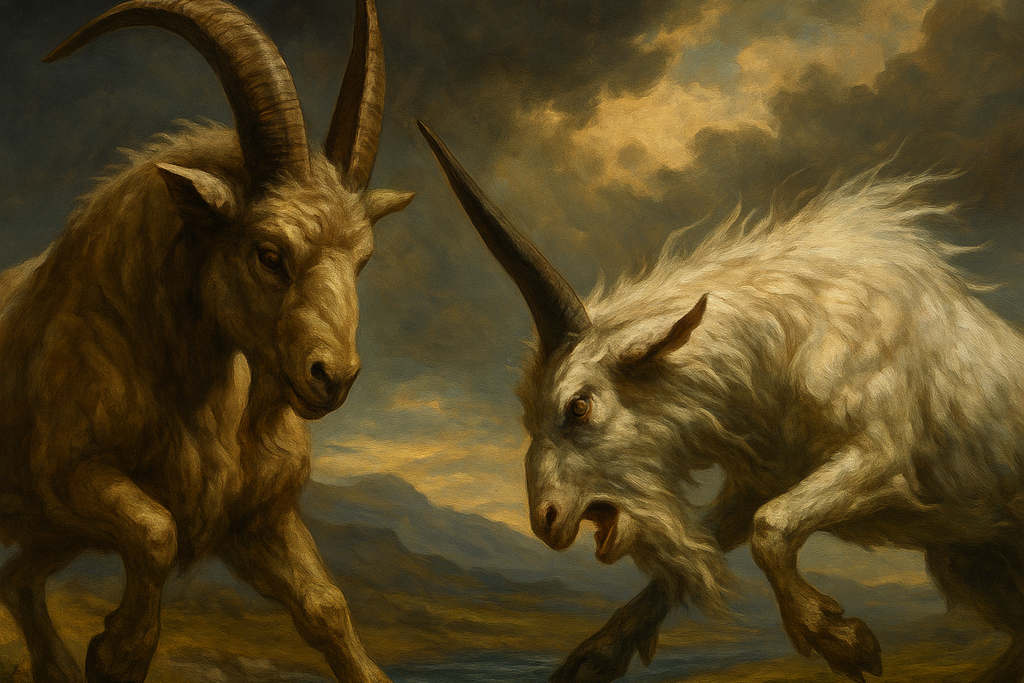The Ram and the Goat
Christian Zionists who expect a future third temple—are in serious error.

The Ram and the Goat
In the eighth chapter of Daniel, we read about a vision in which Daniel sees two beasts. These are clearly identified as representing the Persian and Greek empires.
“Understand, O son of man, that the vision is for the time of the end… Behold, I will make known to you what shall be at the latter end of the indignation; for it pertains to the appointed time of the end” (Daniel 8:17, 19).
This third vision shares strong similarities with the earlier ones. Like them, it helps us identify the four kingdoms. But this one focuses especially on Greece and a powerful figure known as Antiochus Epiphanes.
Daniel describes a ram:
“...a ram standing on the bank of the river. It had two horns; and both horns were high, but one was higher than the other, and the higher one came up last. I saw the ram charging westward and northward and southward; no beast could stand before him, and there was no one who could rescue from his power; he did as he pleased and magnified himself” (Daniel 8:1–4).
The angel explains:
“As for the ram that you saw with the two horns, these are the kings of Media and Persia” (Daniel 8:20).
This vision clearly distinguishes Media from Persia. Media rose to power first, followed by Persia, which became even more dominant. The two horns on the same beast show their alliance.
Daniel sees this ram in Elam, which is significant—it was the homeland of Cyrus the Great. The ram, then, primarily symbolizes the empire Cyrus founded which united Media and Persia.
The Goat and the Conspicuous Horns
“As I was considering, behold, a goat came from the west across the face of the whole earth, without touching the ground; and the goat had a conspicuous horn between his eyes. He came to the ram with the two horns, which I had seen standing on the bank of the river, and he ran at him in his mighty wrath. I saw him come close to the ram, and he was enraged against him and struck the ram and broke his two horns; and the ram had no power to stand before him, but he cast him down to the ground and trampled upon him; and there was no one who could rescue the ram from his power. Then the goat magnified himself exceedingly; but when he was strong, the great horn was broken, and instead of it there came up four conspicuous horns toward the four winds of heaven” (Daniel 8:5–8).
The angel explains further:
“The goat is the king of Greece; and the great horn between his eyes is the first king. As for the horn that was broken, in place of which four others arose, four kingdoms shall arise from his nation, but not with his power” (Daniel 8:21–22).
This vision vividly portrays the swift and overwhelming power of the Greek conquest. The large horn represents Alexander the Great, and the four horns that follow represent the four kingdoms established by his generals after his death.
The angel Gabriel continues:
“At the latter end of their [the four kingdoms'] rule, when the transgressors have reached their full measure, a king of bold countenance, one who understands riddles, shall arise. His power shall be great, and he shall cause fearful destruction, and shall succeed in what he does, and destroy mighty men and the people of the saints. By his cunning he shall make deceit prosper under his hand, and in his own mind he shall magnify himself. Without warning he shall destroy many; and he shall even rise up against the Prince of princes; but, by no human hand, he shall be broken” (Daniel 8:23–25).
Antiochus Epiphanes
This passage clearly refers to Antiochus Epiphanes. After the death of Alexander the Great, his empire was divided among his generals with four main rulers taking control. During this period, Antiochus Epiphanes became king of Syria. He was not an important figure at first, but he used trickery and manipulation to gain power.
Antiochus tried to destroy the Jewish religion. He attacked faithful Jews (called “the host of heaven” and “the people of the saints”) and killed their leaders (called “the stars”). He made himself seem great—even claiming to be a god. He entered the Jewish temple, stopped the daily sacrifices, and set up an altar to the Greek god Zeus, claiming that he himself was Zeus in human form.
Over time, many Jews began to adopt Greek culture and turn away from God’s laws. This growing sin is what the prophecy calls the “full measure” of transgression. When Antiochus heard that some Jews resisted and remained faithful to God, he threatened to destroy all the Jews completely. But something unexpected happened. Antiochus died in great pain—reportedly from disease and worms. Many see this as fulfilment of Daniel's prophecy as he was not killed by any human being; instead, “the Prince of princes”, a title for Jesus Christ, destroyed him even before his human birth.
Prophecy Fulfilled
Everything Daniel saw was completely fulfilled. The ram, representing the Medo-Persian Empire, was destroyed by the goat, representing Greece. After Alexander the Great’s death, the Greek Empire was divided into four parts. From one of these kingdoms came Antiochus Epiphanes, who rose up against God but was destroyed by the Prince of princes.
Daniel’s vision was said to be about “the time of the end”—and it was. After the fall of the Greek Empire, the last of the four kingdoms prophesied in the Book of Daniel, Jesus appeared in human form and brought the Old Covenant to an end, ensuring it would not be reinstated by allowing the destruction of the temple in Jerusalem in 70 AD.
Those who reject the clear fulfillment of Daniel’s prophecies—such as Christian Zionists who expect a future reconstitution of the Roman Empire and the building of a third temple—are in serious error. Their view contradicts Scripture. There is no biblical foundation for the belief that another temple must be built only to be destroyed again in a future apocalypse. By embracing this view, they effectively reject the truth of the Bible and, as Paul wrote, they “love a lie.”

